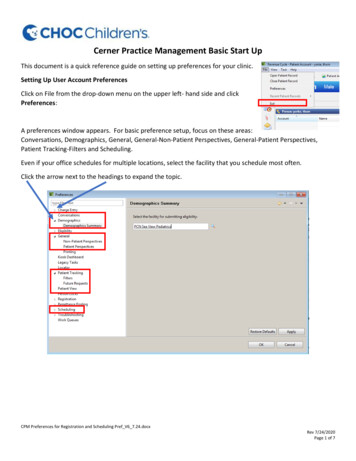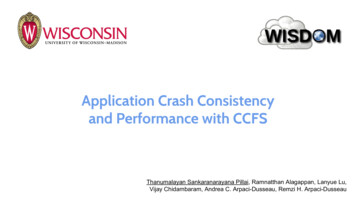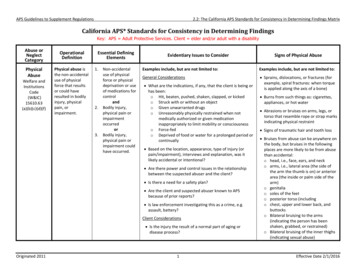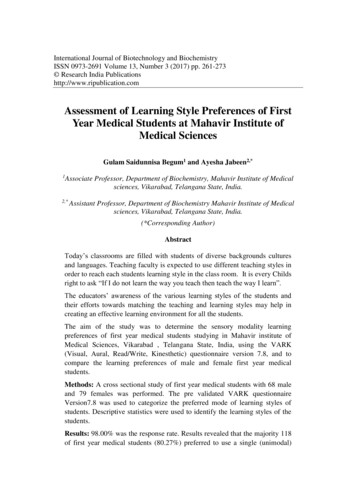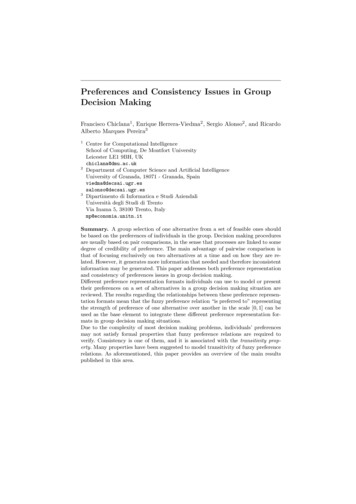
Transcription
Preferences and Consistency Issues in GroupDecision MakingFrancisco Chiclana1 , Enrique Herrera-Viedma2 , Sergio Alonso2 , and RicardoAlberto Marques Pereira3123Centre for Computational IntelligenceSchool of Computing, De Montfort UniversityLeicester LE1 9BH, UKchiclana@dmu.ac.ukDepartment of Computer Science and Artificial IntelligenceUniversity of Granada, 18071 - Granada, rtimento di Informatica e Studi AziendaliUniversità degli Studi di TrentoVia Inama 5, 38100 Trento, Italymp@economia.unitn.itSummary. A group selection of one alternative from a set of feasible ones shouldbe based on the preferences of individuals in the group. Decision making proceduresare usually based on pair comparisons, in the sense that processes are linked to somedegree of credibility of preference. The main advantage of pairwise comparison isthat of focusing exclusively on two alternatives at a time and on how they are related. However, it generates more information that needed and therefore inconsistentinformation may be generated. This paper addresses both preference representationand consistency of preferences issues in group decision making.Different preference representation formats individuals can use to model or presenttheir preferences on a set of alternatives in a group decision making situation arereviewed. The results regarding the relationships between these preference representation formats mean that the fuzzy preference relation “is preferred to” representingthe strength of preference of one alternative over another in the scale [0, 1] can beused as the base element to integrate these different preference representation formats in group decision making situations.Due to the complexity of most decision making problems, individuals’ preferencesmay not satisfy formal properties that fuzzy preference relations are required toverify. Consistency is one of them, and it is associated with the transitivity property. Many properties have been suggested to model transitivity of fuzzy preferencerelations. As aforementioned, this paper provides an overview of the main resultspublished in this area.
Preferences and Consistency Issues in Group Decision Making2171 IntroductionGroup Decision-Making (GDM) consists of multiple individuals interacting toreach a decision. Each decision maker (expert) may have unique motivationsor goals and may approach the decision process from a different angle, buthave a common interest in reaching eventual agreement on selecting the ‘best’option(s) [11, 32].Decisions depend, at least in part, on preferences [14]. Indeed, the followingquotation from Fishburn [13] fully justifies the above in the context of GDM:Democratic theory is based on the premise that the resolution ofa matter of social policy, group choice or collective action should bebased on the desires or preferences of the individuals in the society,group or collectiveIn order to reach a decision, experts have to express their preferences bymeans of a set of evaluations over a set of alternatives. It has been commonpractice in research to model GDM problems in which all the experts expresstheir preferences using the same preference representation format. However,in real practice this is not always possible because each expert has his/herunique characteristics with regard to knowledge, skills, experience and personality, which implies that different experts may express their evaluations bymeans of different preference representation formats. In fact, this is an issuethat recently has attracted the attention of many researchers in the area ofGDM, and as a result different approaches to integrating different preferencerepresentation formats have been proposed [5–7, 12, 23, 23, 49, 50].In many situations decision processes are based on preference relations,in the sense that processes are linked to some degree of preference of anyalternative over another. The main advantage of pairwise comparison is thatof focusing exclusively on two alternatives at a time and on how they arerelated. However, it generates more information that needed and thereforeinconsistent information may be generated.This paper addresses both preference representation formats and the consistency of preferences issues in group decision making. A review of the mainresults on integration of preference representation structures will be given inSection 2, while the problem of consistency when working with fuzzy preference relations will be reviewed in Section 3. In Section 4 we make note theexistence of a conflict between the definition of a consistent multiplicativepreference relation and the scale proposed to provide a such preference relation. Obviously, the same problem exists when dealing with fuzzy preferencerelations. In order to overcome this problem, In Section 5 we propose a set ofconditions to be verified by a function in order to model consistency of fuzzypreferences. Finally, in Section 6 we draw our conclusions.
218F. Chiclana, et al.2 Preference Representation Formats: IntegrationExperts may provide preferences on a set of alternatives, X {x1 , x2 , . . . , xn }(n 2), by using many different representation formats. Among these formatswe have:A preference ordering of the alternativesIn this case, an expert, ek , gives his preferences on X as an individual preference ordering, Ok {ok (1), ., ok (n)}, where ok (·) is a permutation functionover the index set, {1, ., n}, for the expert, ek , [5, 42]. Therefore, accordingto this point of view , an ordered vector of alternatives, from best to worst,is given.A utility functionIn this case, an expert, ek , gives his preferences on X as a set of n utilityvalues, U k {uki , i 1, ., n}, uki [0, 1], where uki represents the utilityevaluation given by the expert ek to the alternative xi [30, 47].A preference relationIn the classical preference modelling, given two alternatives, an expert judgesthem in one of the following ways: (i) one alternative is preferred to another;(ii) the two alternatives are indifferent to him/her; (iii) he/she is unable tocompare them.According to these cases, three binary relations can be defined: (i) thestrict preference relation P : (x, y) P if and only if the expert prefers x to y;(ii) the indifference relation I: (x, y) I if and only if the expert is indifferentbetween x and y; (iii) the incomparability relation J: (x, y) J if and only ifthe expert unable to compare x and y.Fishburn in [14] defines indifference as the absence of strict preference. Healso points out that indifference might arise in three different ways: (a) whenan expert truly feels that there is no real difference, in a preference sense, between the alternatives; (b) when the expert is uncertain as to his/her preference between the alternatives because ‘he might find their comparison difficultand may decline to commit himself[/herself] to a strict preference judgementwhile not being sure that he[/she] regards [them] equally desirable (or undesirable)’; (c) or when both alternative are considered incomparable on apreference basis by the expert. It is obvious from the third case that Fishburntreats the incomparability relation as an indifference relation, i.e., J is empty(there is no incomparability).A preference structure on a set of alternatives X is defined as a triplet(P, I, J) of binary relation in X that satisfy [38, 39]:1. P is irreflexive and asymmetrical2. I is reflexive and symmetrical
Preferences and Consistency Issues in Group Decision Making2193. J is irreflexive and symmetrical4. P I P J I J 5. P P t I J A2where P t is the transpose (or inverse) of P : (x, y) P (y, x) P t . Condition 5 is called the completeness condition.In [38] it is proved that a preference structure (P, I, J) on a se of alternatives X can be characterised by the single reflexive relation R P I:(x, y) R if and only if “x is as good as y”. R is called the large preference relation of (P, I, J). Conversely, given any reflexive binary relation Rin X, a preference structure (P, I, J) can be constructed on it as follows:P R (Rt )c , I R Rt , J Rc (Rt )c , where Rc is the complement ofR: (x, y) R (y, x) / Rc .When using numerical representations of preferences on a set of alternatives X, we have [13]:rij 1 the expert prefers xi to xj xi xjrij 0 the expert prefers xj to xi xj xiClearly, this can be extended by adding the indifference case:rij 0.5 the expert is indifferent between xi and xj xi xjHowever, if xi is preferred to xj and xj to xk , the question whether the“degree or strength of preference” of xi over xj exceeds, equals, or is less thanthe “degree or strength of preference” of xj over xk cannot be answered by theclassical preference modelling. The implementation of the degree of preferencebetween alternatives may be essential in many situations. Take for examplethe case of 3 alternatives {x, y, z} and 2 experts. If one of the experts prefers xto y to z, and the other prefers z to y to x then using the above values it maybe difficult or impossible to decide which alternative is the best. This may benot the case if intensities of preferences are allowed in the above model. AsFishburn points out in [13], if alternative y is closer to the best alternativethan to the worst one for both experts then it might seem appropriate to“elect” it as the social choice, while if it is closer to the worst than to thebest, then it might be excluded from the choice set. Intensity of preferencescan be implemented when modelling preferences by using fuzzy preferencerelations [51] or multiplicative preference relations [40].A fuzzy preference relation R on a set of alternatives X is a fuzzy set on theproduct set X X, that is characterized by a membership functionµR : X X [0, 1].When cardinality of X is small, the preference relation may be convenientlyrepresented by the n n matrix R (rij ) being rij µR (xi , xj ) i, j {1, . . . , n}. The element rij R is usually interpreted as the preference degree
220F. Chiclana, et al.of the alternative xi over xj , as follows [46]: rij 1/2 indicates indifferencebetween xi and xj (xi xj ), rij 1/2 represents an uncertain preference of xiover xj (xi xj ) with rij 1 when xi is definitely (certainly) preferred to xj .In this case, the preference matrix, R, is usually assumed additive reciprocal,i.e.,rij rji 1 i, j {1, . . . , n}.A multiplicative preference relation A on a set of alternatives X is representedby a matrix A XxX, A (aij ), being aij interpreted as the ratio of thepreference intensity of alternative xi to that of xj , i.e., it is interpreted as xiis aij times as good as xj . Saaty suggests measuring aij using a ratio-scale,and precisely the 1 to 9 scale: aij 1 indicates indifference between xi andxj , aij 9 indicates that xi is absolutely preferred to xj , and aij {1, . . . , 9}indicates intermediate preference evaluations. In this case, the preference relation, A, is usually assumed multiplicative reciprocal, i.e.,aij · aji 1 i, j {1, . . . , n}.In the context of GDM with heterogeneous information, an interestingquestion to answer is that of the relationship between the different preferencerepresentation formats.Preference Orderings and Utility Functions Binary Preference RelationsClearly, from a preference ordering on X we can derive a binary preferencerelationxi xj o(i) o(j) i, j 1, . . . , n,Also, given an utility function on X, a preference ordering, and consequentlya classical preference relation, can easily be derived as followso(i) o(j) u(xi ) u(xj ) i, j 1, . . . , n,Binary Preference Relations Preference Orderings and Utility FunctionsGiven a binary preference relation, it is not always possible to assure theexistence of a unique preference ordering or an utility function verifying theabove equivalence. In order to get a positive answer additional conditions haveto be imposed to the preference relation.Given the binary preference relation is preferred to ( ) on a countable setX, with is indifferent to ( ) defined as x y if neither x y nor y x,a fundamental result is that there exists an utility function u : X R suchthatx y u(x) u(y)if and only if on X is a weak order, i.e., it is transitive (x y y z x z), irreflexive (we never have x x) and is transitive (x y y z x z) [15]. The utility function u is said to represent the preference relation
Preferences and Consistency Issues in Group Decision Making221 . Obviously, in this case, any (positive) monotonic transformation of theutility function u is also a utility function representing the same preferencerelation because such a transformation preserves the ranking order of theoriginal utility numbers. So, if we begin with the utility function u and thenuse the (positive) monotonic transformation f to get a new function v definedas v(x) f (u(x)), then v is also a utility function representing the samepreference relation as u.Fuzzy Preference Relations Preference Orderings and Utility FunctionsGiven a fuzzy preference relation on a finite set of alternatives X, not necessarily reciprocal, Wang proved in [48] that if the following acyclic propertywas verified i1 , i2 , . . . , im {1, 2, . . . , n} :ri1 i2 ri2 i1 , ri2 i3 ri3 i2 , . . . , rim im 1 rim 1 im ri1 im rim i1then a total order can be produced in X, i.e, given any two arbitrary alternatives xi and xj in X, one of the following relations holds: xi xj , xj xi ,xi xj . A similar result was obtained in [2] when the fuzzy preference relationis reciprocal and is weakly transitive (rij 0.5 rjk 0.5 rik 0.5).With fuzzy preference relations, Orlovsky [37] proposed a rational criterionsto produce a total order on X based on the strict preference relation Rs (rij)swith rij max{rij rji , 0} and the concept of non-dominance. Conditionsthat guarantee the existence of un-fuzzy non-dominated alternatives were obtained by Montero and Tejada (see [35,36]) and by Kolodziejczyk [29]. A quantifier non-dominance degree that extended Orlovsky’s non-dominance degreewas proposed by Chiclana et al. in [4].Preference Orderings and Utility Functions Fuzzy Preference RelationsIn [5, 6, 22] the following results were obtained:Proposition 1. Let X be a set of alternatives and λki represents an evaluationassociated to alternative xi , indicating the performance of that alternativeaccording to a point of view (expert or criteria) ek . Then, the intensity ofkpreference of alternative xi over alternative xj , rij, for ek is given by thefollowing transformation functionkrij ϕ(λki , λkj ) 1· [1 ψ(λki , λkj ) ψ(λkj , λki )],2where ψ is a function verifying1. ψ(z, z) 12 , z R.2. ψ is non decreasing in the first argument and non increasing in the secondargument.
222F. Chiclana, et al.Utility Values and Fuzzy Preference RelationsCorollary 1. If λki uki and s(z) if (z, y) 6 (0, 0)ψ(z, y) s(z) s(y)1 if (z, y) (0, 0)2where s : [0, 1] : R is a non decreasing and continuous function, verifyings(0) 0, then ϕ transforms utility values given on the basis of a ratio scale2into fuzzy preference relations. In particular, if ψ(x, y) x2x y2 , thenkrij f1uki , ukj ukiuki 2 2 ukjPreference Orderings and Fuzzy Preference Relations 2Corollary 2. If λki ok (i), and ψ(λki , λkj ) F (λkj λki ), where F is anynon decreasing function, then ϕ transforms preference orderings into fuzzypreference relations.y x, thenIn particular, if ψ(x, y) 2(n 1)krij f2oki , okj 1 2okj oki1 n 1!Multiplicative Preference Relations and Fuzzy Preference RelationsProposition 2. Let X be a set of alternatives,and associated with it a mul tiplicative preference relation Ak akij . Then, the corresponding additive k, associated with Ak is given as follows:fuzzy preference relation, Rk rij 1 krij g akij 1 log9 akij2These results may justify the choice of fuzzy preference relations as thebase element to integrate these different preference representation formats inGDM context. In the following section we deal with issue of consistency ofpreferences.3 Consistency of PreferencesThere are three fundamental and hierarchical levels of rationality assumptionswhen dealing with preference relations [18]: The first level of rationality requires indifference between any alternativeand itself.
Preferences and Consistency Issues in Group Decision Making223 The second one assumes the property of reciprocity in the pairwise comparison between any two alternatives. Finally, the third one is associated with the transitivity in the pairwisecomparison among any three alternatives.The mathematical modelling of all these rationality assumptions obviouslydepends on the scales used for providing the preference values [9,16,26,40,46].A preference relation verifying the third level of rationality is usually calleda consistent preference relation and any property that guarantees the transitivity of the preferences is called a consistency property. The lack of consistency in decision making can lead to inconsistent conclusions; that is why itis important, in fact crucial, to study conditions under which consistency issatisfied [16, 26, 40].In a crisp context, where an expert provides his/her opinion on the setof alternatives X by means of a binary preference relation, R, the conceptof consistency it has traditionally been defined in terms of acyclicity [43],that is the absence of sequences such as x1 , x2 , . . . , xk (xk 1 x1 ) withxj Rxj 1 j 1, . . . , k. Clearly, this condition as said before is closely related to the transitivity of the binary relation and its corresponding binaryindifference relation.In a fuzzy context, where an expert expresses his/her opinions using fuzzypreference relations, R, or multiplicative preference relations, in the case ofSaaty’s method, A, the traditional requirement to characterise consistencyhas followed the way of extending the classical requirements of binary preference relations. Thus, in these cases consistency is also based on the notionof transitivity, in the sense that if alternative xi is preferred to alternative xjand this one to xk then alternative xi should be preferred to xk . The maindifference in these cases with respect to the classical one is that transitivityhas been modelled in many different ways due to the role the intensities ofpreference have [16, 19–21, 26, 40, 46, 52].Due to the hierarchical structure of the three rationality assumptions for apreference relation, the verification of a particular level of rationality should bea necessary condition in order to verify the next level of rationality. This meansthat the third level of rationality, transitivity of preferences, should imply orbe compatible with the second level of rationality, reciprocity of preferences,and the second level with the first one, indifference of any alternative withitself.This necessary compatibility between the rationality assumptions can beused as a criterion for considering a particular condition modelling any oneof the rationality levels as adequate or inadequate. In the case of fuzzy (multiplicative) preference relations, the indifference between any alternative, xi ,and itself is modelled by associating the preference value rii 0.5 (aii 1).The reciprocity of fuzzy (multiplicative) preferences is modelled using theproperty rij rji 1, i, j (aij · aji 1, i, j). A necessary condition fora preference relation to verify reciprocity should be that indifference between
224F. Chiclana, et al.any alternative and itself holds. Because reciprocity property implies the indifference of preferences, we conclude that both properties are compatible.In the case of multiplicative preference relations Saaty means by consistency what he calls cardinal transitivity in the strength of preferences, whichis a stronger condition than the traditional requirement of the transitivity ofpreferences [40]:Definition 1. A reciprocal multiplicative preference relation A (aij ) is consistent if aij · ajk aik i, j, k 1, . . . , n.Inconsistency for Saaty is a violation of proportionality which may not entail violation of transitivity [40]. Furthermore, consistency implies reciprocity,and therefore, they are both compatible.In [40] Saaty shows that a reciprocal multiplicative preference relationis consistent if and only if its maximum or principal eigenvalue λmax isequal to the number of alternatives n. Under this consistency property, Saatyproves that there exists a set of priorities (utilities) {λ1 , λ2 , . . . , λn } such thataij λλji . Moreover, this set of values is unique up to positive linear transformation f (λi ) β · λi with β 0. Thus, if a multiplicative preference relationis consistent then it can be represented by a unique (up to positive lineartransformations) utility function.For fuzzy preference relations, there exist many properties or conditionsthat have been suggested as rational conditions to be verified by a consistentrelation. Among these, we can citethe following:1. Triangle condition [30]: rij rjk rik i, j, k.This condition can be geometrically interpreted considering alternativesxi , xj , xk as the vertices of a triangle with length sides rij , rjk and rik[30], and therefore the length corresponding to the vertices xi , xk shouldnot exceed the sum of the lengths corresponding to the vertices xi , xjand xj , xk .2. Weak transitivity [46]: rij 0.5, rjk 0.5 rik 0.5 i, j, k.The interpretation of this condition is the following: If xi is preferred toxj and xj is preferred to xk , then xi should be preferred to xk . Thiskind of transitivity is the usual transitivity condition (xi is preferred toalternative xj and this one to xk then alternative xi should be preferred toxk ) a logical and consistent person should use if he/she does not want toexpress inconsistent opinions, and therefore it is the minimum requirementcondition that a consistent fuzzy preference relation should verify.3. Max-min transitivity [9, 52]: rik min(rij , rjk ) i, j, k.The idea represented here is that the preference value obtained by a directcomparison between two alternatives should be equal to or greater thanthe minimum partial values obtained when comparing both alternativeswith an intermediate one. This kind of transitivity has been the traditionalrequirement to characterise consistency in the case of fuzzy preference relations [52], although it is a very strong concept that it could not be
Preferences and Consistency Issues in Group Decision Making225verified even when a fuzzy preference relation is considered perfectly consistent from a practical point of view. For example, let us consider a setof three alternatives X {x1 , x2 , x3 }, such that x1 x2 x3 . Supposethat the opinions about these alternatives are given by the following fuzzypreference relation 0.5 0.1 0R 0.9 0.5 0.4 .1 0.6 0.5On the one hand, this matrix reflects the fact that x1 x2 x3 ; it verifiesweak transitivity and the triangle condition. On the other hand, it doesnot verifies max-min transitivity because r13 min{r12 , r23 }.4. Max-max transitivity [9, 52]: rik max(rij , rjk ) i, j, k.This concept represents the idea that the preference value obtained by adirect comparison between two alternatives should be equal to or greaterthan the maximum partial values obtained when comparing both alternatives using an intermediate one. This is a stronger concept than max-mintransitivity and therefore if a fuzzy preference relation does not verify thelatter neither verifies the former.5. Restricted max-min transitivity [46]: rij 0.5, rjk 0.5 rik min(rij , rjk ) i, j, k.When a fuzzy preference relation verifies this condition it is modelled theconcept that when an alternative xi is preferred to xj with a value pijand xj is preferred to xk with a value rij , then xi should be preferredto xk with at least an intensity of preference rik equal to the minimumof the above values. The inequality should becomes equality only whenthere exist indifference between at least two of the three alternatives. Aconsistent fuzzy preference relation has to verify this condition, which goesa step further than weak transitivity because add an extra requirementabout the degrees of preferences involved. This transitivity condition istherefore stronger than weak transitivity but it is milder than max-mintransitivity. It is easy to prove that the above fuzzy preference relation Rverifies restricted max-min transitivity.6. Restricted max-max transitivity [46]: rij 0.5, rjk 0.5 rik max(rij , rjk ) i, j, k.In this case it is modelled the concept that when an alternative xi is preferred to xj with a value rij and xj is preferred to xk with a value rij ,then xi should be preferred to xk with at least an intensity of preferencerik equal to the maximum of the above values. As in the previous case,the the equality should hold only when there exist indifference betweenat least two of the three alternatives, in which case, restricted max-maxtransitivity and restricted max-min transitivity coincide. It is clear thatthis concept is, on the one hand, stronger than restricted max-min transitivity and, on the other hand, milder than max-max transitivity. Thisconcept has been considered by Tanino [46] as a compulsory condition to
226F. Chiclana, et al.be verified by a consistent fuzzy preference relation. It is easy to prove thatthe fuzzy reciprocal preference relation R, given above, verifies restrictedmax-max transitivity.rji rkjki· rjk rrik7. Multiplicative transitivity [46]: rij i, j, k.Tanino in [46] introduced this concept of transitivity only in the case ofbeing rij 0 i, j, and interpreting rij /rji as a ratio of the preferenceintensity for xi to that of xj , i.e., xi is rij /rji times as good as xj . Multiplicative transitivity includes restricted max-max transitivity [45,46], andrewritten as rij · rjk · rki rik · rkj · rji i, j, k. In the case of a reciprocalfuzzy preference relation this expression can be expressed in the followingform: i, j, k :rij · rjk · (1 rik ) rik · rkj · rji rij · rjk rij · rjk · rik rik · rkj · rji rik · rkj · rji rij · rjk · rik rij · rjk rik · (rkj · rji rij · rjk ) rij · rjk rij · rjk rik rij · rjk rji · rjkrij · rjkrik rij · rjk (1 rij ) · (1 rjk )This expression is a well known andlike uninorm which is self-dual withrespect to the negator operator N (x) 1 x (for more details see [17,28]).This type of transitivity has also been studied by De Baets et al. in [8]within a general framework of transitivity of reciprocal fuzzy preferencerelations, the cycle-transitivity, under the name of ‘isostochastic transitivity’. This is also a symmetric sum in the sense of Silvert [44] thathas been applied for information combination in approximate reasoning(see [10] and cites within it).8. Additive transitivity [45, 46]: (rij 0.5) (rjk 0.5) (rik 0.5) i, j, k,or equivalently rij rjk rki 23 i, j, k.This kind of transitivity has the following interpretation: suppose we wantto establish a ranking between three alternatives xi , xj and xk , and thatthe information available about these alternatives suggests that we arein an indifference situation, i.e. xi xj xk . When giving preferencesthis situation would be represented by rij rjk rik 0.5. Supposenow that we have a piece of information that says xi xj , i.e. rij 0.5.This means that rjk or rik have to change, otherwise there would be acontradiction, because we would have xi xj xk xi . If we supposethat rjk 0.5 then we have the situation: xj is preferred to xi and thereis no difference in preferring xj to xk . We must then conclude that xkhas to be preferred to xi . Furthermore, as xj xk then rij rik , andso (rij 0.5) (rjk 0.5) (rij 0.5) (rik 0.5). We have the sameconclusion if rik 0.5. In the case of rjk 0.5, then we have that xk ispreferred to xj and this to xi , so xk should be preferred to xi . On the otherhand, the value rik has to be equal to or lower than rij , being equal only
Preferences and Consistency Issues in Group Decision Making227in the case of rjk 0.5 as we have already shown. Interpreting the valuerji 0.5 as the intensity of strict preference of alternative xj over xi , thenit seems reasonable to suppose that the intensity of preference of xi overxk should be equal to the sum of the intensities of preferences when usingan intermediate alternative xj , that is, rik 0.5 (rij 0.5) (rjk 0.5).The same reasoning can be applied in the case of rjk 0.5 [26, 45, 46].The fuzzy preference relation R, given above, verifies additive transitivity.The following diagram shows all logical relationships between the definedtransitivity conditions. We note that there is no relationship between weaktransitivity and triangle condition [30],(7) (1) (8) (6) (5) (2) (4) (3)In the following, we will show that max-max transitivity is not compatiblewith the reciprocity property. If a fuzzy preference relation verifies max-maxtransitivity and reciprocity then rik max{rij , rjk } i, j, k and rij 1 rji } i, j, which implies:1 rik 1 max{rij , rjk } i, j, k rki min{rkj , rji } i, j, kwhich contradicts max-max transitivity. The same conclusion can be obtainedregarding max-min transitivity. Therefore both properties are not adequateproperties to model the transitivity for fuzzy preference relations.If we examine the relationship between restricted max-max transitivityand reciprocity, then we conclude that the fuzzy preference relation also hasto verify the complementary restricted min-min transitivity, that is, i, j, k : min{rij , rjk } 0.5 rik min{rij , rjk }.However, nor restricted max-max transitivity nor restricted min-min transitivity imply reciprocity. For example, the following fuzzy preference relation 0.5 0.6 0.8R
3 Dipartimento di Informatica e Studi Aziendali Universit a degli Studi di Trento Via Inama 5, 38100 Trento, Italy mp@economia.unitn.it Summary. A group selection of one alternative from a set of feasible ones should be based on the preferences of individuals in the group. Decision making procedures
